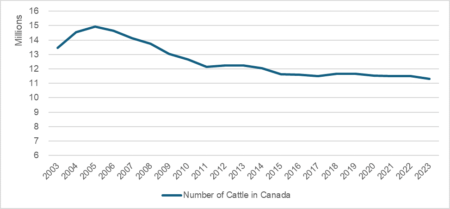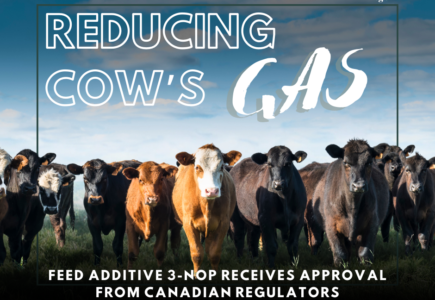Enteric methane emissions, or cow “farts” is something we have been hearing much about over the past three decades. It has generated a negative perception of beef production concerning climate change. This threatens the economic viability of our beef industry as social license becomes more crucial with each passing year. Currently, methane emissions represent 14% of Canadian greenhouse gas emissions by volume, while agriculture comprises 8.2% of all Canadian emissions, regardless of the gas type. Nonetheless, enteric methane comprised 43% of total agricultural emissions in 2020 (or 3.5% of all Canadian emissions), making ruminants the enemy of numerous activist groups and political figures. To maintain the economic and ecosystem benefits associated with beef production, overcome negative perceptions, and ensure the next generation of beef producers can prosper, emissions solutions are required.
One solution is a new livestock feed known as 3-nitrooxyproponal (3-NOP), which was recently approved in the EU and US for use in commercial feedlots and dairies. The efficacy of the feed additive has been extensively researched and trialed across the globe, displaying largely positive results for emissions reductions. A Penn State research program found the addition of 3-NOP in their dairy cattle feed to reduce emissions by 25%. Given the method of application, which is adding the substance to feed, 3-NOP is not generally applicable to cow-calf operations. Cow calf operations are extensive, meaning the animals graze and are not typically fed in a controlled environment. However, the emission reduction results could still be substantial if adopted on a broad scale. In a September 2023 blog, I stressed the importance of approving 3-NOP in a Canadian setting; at that time it appeared the additive would be subject to a lengthy regulatory approval period. In January of 2024, to the surprise of many in the industry, 3-NOP was approved for use in Canada. This blog will discuss the significance of this approval, the application of 3-NOP in a Canadian context, alongside the need for consumer demand for these products.
Emission reductions – limited to intensive operations
Being that 3-NOP is currently only available in a granular form, its use in extensive cattle operations is limited. That is, cow-calf producers are unable to use the product on pastures or in high forage diets. Given that 78% of enteric emissions can be attributed to cow-calf enterprises, the advent of 3-NOP in Canada may seem insignificant; however, this is not the case. The cyclical nature of methane emissions in the cow-calf sector, alongside the biodiversity and carbon sequestration benefits of grasslands, enable this segment of the beef supply chain to operate with minimal opposition in many cases. However, commercial feedlots, dairy barns, and other intensive livestock operations are often mislabelled as factory farming. In beef cattle feedlots, sequestration is limited to the annual feed and forage crops grown to supply the feedlot, while the cow-calf sector provides near-endless positive externalities in this regard.
Crucial to understanding the impact of 3-NOP on emissions and climate change is the cyclical nature of enteric methane emissions. Enteric methane – and all methane for that matter – remains in the atmosphere for 12 years before being converted to carbon dioxide. This carbon dioxide in our atmosphere is absorbed and stored in the plants that are used to feed cattle and the soils below them. Effectively, without an increase in cattle numbers, the contribution of livestock to emissions remains stagnant or decreases. This is not to say emissions are entirely cyclical, as not all enteric methane is reabsorbed by plants. However, this cyclical aspect adds to the potential of technologies such as 3-NOP to mitigate the impact of livestock. Given that Canadian cattle numbers have been steadily decreasing in the past two decades – as displayed in Figure 1 – any reduction in enteric methane emissions will mitigate the volume of greenhouse gases in the atmosphere. However, it must be clarified that removing livestock is not the answer; rather, it is livestock efficiency and size gains combined with enteric methane inhibitors that may provide an emissions solution.

Canadian Context
If Canadian beef producers are to meet the substantial 33% methane emissions reduction goal they set for themselves by 2030, the steps to reduce emissions must occur briskly. Hence, the regulatory approval of 3-NOP occurred meticulously yet much faster than originally expected by many industry experts. The Federal Government recently involved itself with a voluntary and purportedly incentivized Reducing Enteric Methane Emissions from Beef Cattle Protocol the time for industry action is now. Cattle producers are expected to receive monetizable credits for the implementation of methane reduction strategies of which, 3-NOP will likely be one of the recommended practices. Avoiding proactive measures now risks the advent of mandates in the coming years, something everyone in the industry can agree must be evaded.
Concerning Canadian research into 3-NOP use, many studies have found significant reductions in enteric methane emissions at the feedlot level. A 2021 research effort found that emissions could be reduced by as much as 76% in feedlot steers. Other studies have found reductions ranging from 21-25%, with no impacts on animal health. Results like these display the efficacy of 3-NOP in Canada.
Consumer acceptance and demand
As mentioned, Canadian cattle producers and commercial feedlots have achieved momentous gains in production efficiency, producing larger carcasses in a shorter amount of time. In essence, this has lowered the emissions intensity of beef production, producing a greater volume of production per tonne of GHG emissions. The use of growth hormones was one method of reducing emissions intensity and increasing production efficiency that revolutionized the beef industry. However, the use of growth hormones has developed a substantial number of adversaries despite the rigorous testing and approval processes required to commercialize products of this type. As a result, hormone free beef is now demanding a premium. The inverse should apply if consumers are truly willing to pay for lower-emission food products.
The use of 3-NOP may find itself in a similar position despite significant regulatory oversight and strong communication of the benefits associated with the additive. In a society plagued by dis- and misinformation, it is crucial that 3-NOP be accepted by consumers on its scientific merit and recognised safety. However, receiving acceptance from producers, policymakers, and consumers is not enough. Some portion of the supply chain will have to bear the cost of this additive. To account for the margin loss that will be experienced when 3-NOP is implemented, consumers must be willing to pay a premium for beef produced with the additive. Given the controversial track record of acceptance of other sustainability-enhancing innovations, such as growth hormones, antibiotics, and GMOs, it raises concerns that beef produced with 3-NOP may receive a price discount. If this is the case, the government would have to decide whether they subsidize or mandate the use of 3-NOP. A subsidization is not likely to sit well with taxpayers and a mandate certainly would receive staunch pushback from producers. If 3-NOP does reduce the price for cattlemen, the government will need to decide what side to pick if they wish to reduce the national GHG of ruminant animals.
Uncertainty ahead
The road ahead for this exciting innovation is both uncertain and important. Concerns surrounding consumer acceptance are valid and the need for consumer willingness to pay will undoubtedly become evident if monetizable credits are insufficient for production costs. Beyond this, there is a need for future innovation of 3-NOP and products similar. Adaptations to the product that would make it applicable to the cow-calf sector could make the entire livestock production cycle a large net sink of greenhouse gas emissions, adding to the myriad of benefits already provided by livestock production in Canada.


